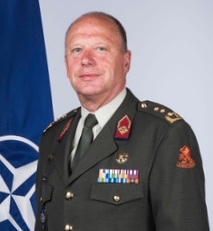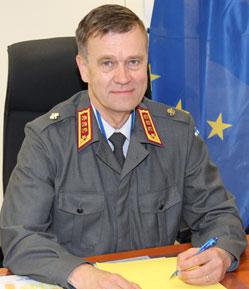NATO Stocks Up on Bombs, Giving Smaller States More Punch
Posted on
WASHINGTON: Over the past month, US Air Forces in Europe took delivery of their largest shipment of ordnance in two decades. It’s another sign of the rearming of the continent as the United States pushes troops and equipment back into the region after years of drawing down, even as its NATO allies — and increasingly, non-allies like Finland — make preparations of their own.
While that American weaponry rolled into Ramstein Air Base, Washington’s NATO allies were moving out on their own ambitious rearmament program — one that could have more far-reaching consequences than the US buildup — signaling a new push by allies to project power and allow smaller members to punch harder.
Back in Belgium, Denmark, and Austria (which is not a NATO member) took delivery of $20 million worth of air-to-ground precision guided munitions. It was the first installment of an ambitious joint ownership program involving eleven NATO countries — along with increasingly de facto ally Finland — aimed at pooling resources to buy advanced munitions and share them on an need-to-have basis.
Both NATO officials and analysts say the acquisition plan is sanding the rough edges off decades of slow-moving and regulation-heavy procurement, which made it extremely difficult for allies to share munitions that most NATO members used. The result was some countries were forced to destroy aging stocks of bombs while others struggled to afford new shipments.
The new program promotes the pooling of air, ground, and sea-launched munitions, allowing countries to trade them within the alliance while giving other members a better idea of which countries are flush and which might be running dry.
The road to the first delivery in August actually began in Libya in 2011, when some NATO states were deeply embarrassed when they literally ran out of bombs during the campaign to help local rebels oust the regime led by Muammar Gaddafi.
Determined not to be caught out again, the alliance agreed at its Wales summit in 2014 to kickstart this joint procurement program, which slashes through reams of red tape and allows states to get needed stocks of bombs quickly.
The idea was to “make our stockpiles more shareable,” a NATO official told me. “So if I have a bunch of munitions that are going to expire and yours are brand new, you can use some of mine that I would otherwise have to expend money to demilitarize.” And then, a few years down the road, “you can give me some of yours and we’ll call it even.”
The need to share the burden of deterrence and readiness has been front and center during the Trump administration, but the idea first gained traction in 2014 in the wake of the Russian invasion of Ukraine. The resulting increase in NATO exercises, along with participation in the bombing campaigns in Iraq and Syria against ISIS, underscored the dangers of paucity — but when some larger nations agreed to ship some of their bombs to friends, “what we found was this was a lot harder to do than we had participated,” the NATO official said.
So the 2014 agreement did away with some of the restrictions surrounding arms transfer, and established a consortium where groups of nations could buy weapons together, and share as needed.
After the first shipment of PGMs in August, the second and third tranches immediately began to take shape for more deliveries.
During the annual NATO summit in Brussels this July, seven member states — Belgium, France, Italy, Netherlands, Poland, Portugal, and Spain — inked a deal to buy a range of maritime munitions including surface-to-air, surface-to-surface missiles and torpedoes, along with kicking off a plan to find a single place to warehouse them all.
Separately, 16 NATO countries — Belgium, Denmark, Estonia, Germany, France, Italy, Latvia, Lithuania, Montenegro, Netherlands, Norway, Poland, Portugal, Slovakia, Slovenia, and Spain — came together to share ground-launched munitions.
The NATO official said that the various deals show that the overall program is not “geared toward any specific munition type. We try and keep it as broad as possible. Whenever the demand might shift, we have a framework in place to respond to requirements, and to make it future-proof, since we don’t know what is happening in five years.”
And while the first agreements are in the books, the alliance is looking to make this a regular feature of how it does business. Officials are working to get into a regular battle rhythm of making deals, looking to have shipments arrive several times a year as they bundle demand.
The program looks to be particularly helpful for small member states, said Henrik Breitenbauch, director of the Center for Military Studies at the University of Copenhagen.
“It’s an important step in integrating the militaries of the smaller NATO members,” Breitenbauch said, “and it helps heighten the readiness of the alliance by making sure munitions are common across any states who want to be part of this burden-sharing program.”
The European Union gets into the game
This month’s Trident Juncture exercise in Norway, featuring 50,000 troops from across the alliance, stands as a test of NATO’s ability to move quickly across air, land, and sea domains. But, alongside munitions stockpiles, another persistent logistical challenge is the ability of member states to move troops across each others’ territory for training exercises or crisis response, in part because of European Union regulations.
Dutch Lt. Gen. Jan Broeks, director general of the alliance’s International Military Staff, said Wednesday that there has been some frustration on that front, and efforts to update individual state’s regulations to allow troops and equipment move across borders “is not moving fast enough.”
“It’s a lot of work,” he told reporters during a visit to Washington, “but we need to be ambitious and we need to be very clear, in a military context.”
Broeks was in town on a goodwill visit alongside Lt. Gen. Esa Pulkkinen, a Finn who serves as director general of the European Union’s military staff. (Finland belongs to the EU but not to NATO, although in practice it’s long since abandoned its Cold War neutrality between Russia and the West). Pulkkinen said the legal issues are complex, but not insurmountable. “These are the areas where you can proceed — some of the issues are in the hands of the EU, some in the hands of the member states,” he said.
The two generals were in town to visit the Pentagon and State Department on a goodwill tour, presenting a united front to Washington policymakers amid ongoing tension between NATO and the EU over planning for a European Union military force.
During a joint appearance at the Center for a New American Security, both men downplayed differences, saying instead of duplicating efforts, the EU force could work alongside NATO, since the troops will be drawn mostly from the same pool of forces.
European Union members Finland and Sweden — another Nordic neutral that’s now working closely with NATO — are taking part in Trident Juncture, something Pulkkinen said is helping building deep ties to the Atlantic alliance.
“We don’t have any EU exercises at all, so any chance to improve the interoperability of the forces, including the EU members’ state forces, is good for us,” he said. “We are very grateful on the EU side that some non-NATO EU allies” are taking part in the massive war game.
Subscribe to our newsletter
Promotions, new products and sales. Directly to your inbox.





